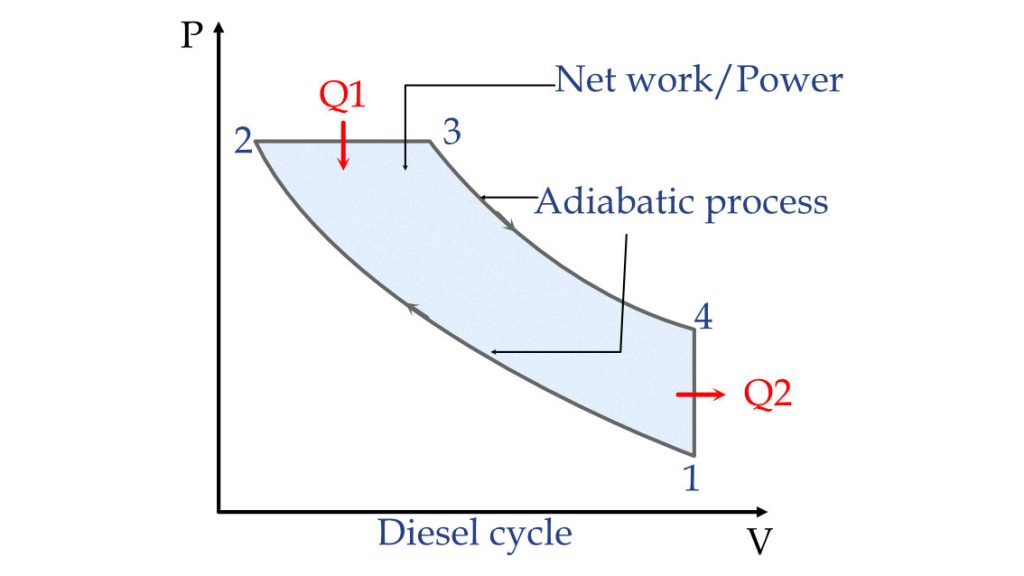Whether it’s big and bulkier diesel engines used in ships and trains or slightly smaller versions used in cars, the working of all these engines is identical; these engines work in the same thermodynamic cycle known as the Diesel cycle. What is the Diesel cycle, and what is the critical factor that differentiates it from the Otto (Petrol) cycle? You will see this in this blog post.
Diesel cycle
The Diesel cycle is the thermodynamic cycle on which the diesel engine works, whether a truck, car, bus, or train. The engine working in all these vehicles is the same and will have four major processes taking place in them. Rudolf Diesel patented this compression engine and proposed this, which is the base of all diesel engines on this planet. In a typical diesel engine, the air is sucked inside the piston cylinder arrangement from the intake valve, followed by air compression. The compression increases pressure and temperature, and the fuel is injected into the cylinder. The sufficiently high-temperature compressed air auto-ignites the air-fuel mixture, which expands in the piston cylinder. This expansion leads to the generation of work. And finally, the burnt mixture is exhausted from the system through the outlet valve.
Diesel cycle thermodynamics
All the above stages in the engine make this cycle. So, the typical cycle comprises four processes: isentropic expansion, compression, isobaric heat addition, and isochoric heat rejection. These processes are of the cycle, as shown in the figure below.

The thermodynamic processes in the cycle include:
- Isentropic compression: In the cycle, it is a constant entropy compression process (isentropic). It is equivalent to the intake valve opening and airflow into the piston cylinder arrangement described above.
- Isobaric heat addition: The constant pressure heat addition process is also known as the isobaric process. The compressed air reaches a sufficiently high temperature that when fuel is sprayed inside the cylinder, it gets auto-ignited. This auto-ignition leads to the generation of heat.
- Isentropic expansion: In the Diesel cycle, it is the constant entropy expansion process (isentropic). And in the diesel engine, the expansion of gasses as a result of heat addition will move the piston down. It is the process by which the engine generates the work.
- Isochoric heat rejection: The last process in the cycle is the constant volume heat rejection process, also known as the isochoric process. Finally, the outlet valve opens when the work is extracted from the gases, allowing the exhaust gases to go out from the cylinder. This stage gives off the highly polluted gases from the silencer.
Diesel cycle efficiency
Generally, most automotive diesel engine working in this operates at around 30% to 35% thermal efficiency. But, the bulkier low-speed diesel engine used in ships can reach thermal efficiencies of 50+%. The thermal efficiency in the case of diesel cycles can be quantified as
$$\eta = 1 – \frac{1}{r^ \gamma – 1}(\frac{\alpha^ {\gamma} – 1}{\gamma (\alpha – 1)})$$
Where r is the compression ratio, the ratio of total and clearance volume and α is the cut-off ratio, i.e., the ratio of volumes at the end and the start of the combustion process.
Usually, Diesel engines give higher efficiency compared to Petrol engines. The credit for this higher efficiency goes to the higher compression ratio used in diesel engines. Since only air is compressed in diesel engines, there is no risk of fuel auto-ignition.
Diesel cycle v/s Otto cycle
Although there is a tremendous difference between a petrol engine and a diesel engine from the design and key components point of view, in their thermodynamics, the difference is simply a change in the heat addition process. In the Otto cycle, the heat addition process is isochoric (i.e., constant volume), whereas in the Diesel cycle, it is isobaric (i.e., constant pressure).
Apart from these, the major difference between diesel and petrol engines are:
- Spark plug: In a petrol engine, a spark plug ignites the air-fuel mixture. Whereas in diesel engine there is no spark plug. The fuel is ignited through auto-ignition.
- Air-fuel mixture: In the diesel engine, only air is taken inside and compressed. Whereas, in the petrol engine, the air-fuel mixture is taken inside and compressed.
Conclusions
Just like the petrol engine works on the Otto cycle, the diesel engine operates on the diesel cycle. This describes the ideal thermodynamic processes that will produce the work if implemented on an engine.
Some key learnings from the post:
- Diesel cycle: The diesel cycle is the thermodynamic cycle on which the compression ignition engine (diesel engine) works. It comprises four processes, one isobaric, one isochoric, and two isentropic processes.
- The efficiency of the Diesel cycle: The efficiency of the Diesel cycle is a function of compression ratio, which is the ratio of total volume and clearance volume. And the cutoff ratio is the ratio of volumes at the end and start of the combustion process.
- Difference between Otto and Diesel cycle: In the Otto cycle, the heat addition process is isochoric (i.e., constant volume), whereas in the Diesel cycle, it is isobaric (i.e., constant pressure).

Android Apps
⭐️ ⭐️ ⭐️ ⭐️ ⭐️ 1000+ | 400,000 + Downloads (Cumulative)
At eigenplus, our goal is to teach civil engineering students about structural analysis and design starting from the fundamental principles. We do this with the help of interactive android applications and accompanying web articles and videos.
Our apps have helped more than 400 thousand students across the world to understand and learn the concepts of structural engineering. Check out our apps on the google play store.